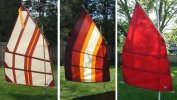Don Tyerman
New Member
Hi fellow canoe-sailors
In 2022 I built a four-cornered spritsail kit from Sailrite. I found it on a webpage of options available from Sailrite and this sail seemed to best fit my needs. I cannot remember the details but the kit came from a boat called “JWB” (or something like that). It is about 30Sq. feet in size.
I have used it on a sailing canoe and the kit has worked out well. More recently I built a small jib from an old kitesurfing kite to increase sail area, improve upwind performance and help with tacking. This small sail has done all of the aforementioned.
However I would like to improve upon two things:
The ability to shorten sail while underway is especially important to me as I often sail solo in remote locations such as the north shore of Lake Superior. The canoe itself is a safety feature in that it can be hauled ashore on almost any beach. However I have been twice caught rounding headlands/crossing bays by sudden squalls. The wind was from behind both times and I was forced to let the sail flag out directly downwind and flap madly. This was inelegant and hard on the sail and rig but it worked…
I am looking for another sail/rig that would be reefable or droppable while underway in sudden wind scenarios. I would like it to work with a jib too as I’ve found the jib adds performance and flexibility that a single sail lacks. Finally a bit more upwind performance would be nice though I recognize that my craft is definitely a compromise boat.
Do you have any thoughts on a new sail that might be suitable for my requirements? I have attached a photo so you can get a better picture of my boat and its rig. (Sorry it's sideways and I don not know how to straighten it.)
Thanks in advance,
Don Tyerman

In 2022 I built a four-cornered spritsail kit from Sailrite. I found it on a webpage of options available from Sailrite and this sail seemed to best fit my needs. I cannot remember the details but the kit came from a boat called “JWB” (or something like that). It is about 30Sq. feet in size.
I have used it on a sailing canoe and the kit has worked out well. More recently I built a small jib from an old kitesurfing kite to increase sail area, improve upwind performance and help with tacking. This small sail has done all of the aforementioned.
However I would like to improve upon two things:
- Ability to shorten sail while underway
- Hopefully improve upwind performance a bit.
The ability to shorten sail while underway is especially important to me as I often sail solo in remote locations such as the north shore of Lake Superior. The canoe itself is a safety feature in that it can be hauled ashore on almost any beach. However I have been twice caught rounding headlands/crossing bays by sudden squalls. The wind was from behind both times and I was forced to let the sail flag out directly downwind and flap madly. This was inelegant and hard on the sail and rig but it worked…
I am looking for another sail/rig that would be reefable or droppable while underway in sudden wind scenarios. I would like it to work with a jib too as I’ve found the jib adds performance and flexibility that a single sail lacks. Finally a bit more upwind performance would be nice though I recognize that my craft is definitely a compromise boat.
Do you have any thoughts on a new sail that might be suitable for my requirements? I have attached a photo so you can get a better picture of my boat and its rig. (Sorry it's sideways and I don not know how to straighten it.)
Thanks in advance,
Don Tyerman
Last edited by a moderator:


![20240830_170315[1].jpg](/data/attachments/53/53336-c2960b1380bfc5edd49a8eb5767ee2c9.jpg?hash=2OkvWlhTLX)
![Screenshot_20251005_171546_Geo_Tracker[1].jpg](/data/attachments/53/53337-b83e208395180fa09044e81314e43ff2.jpg?hash=bdRTNNHfao)

